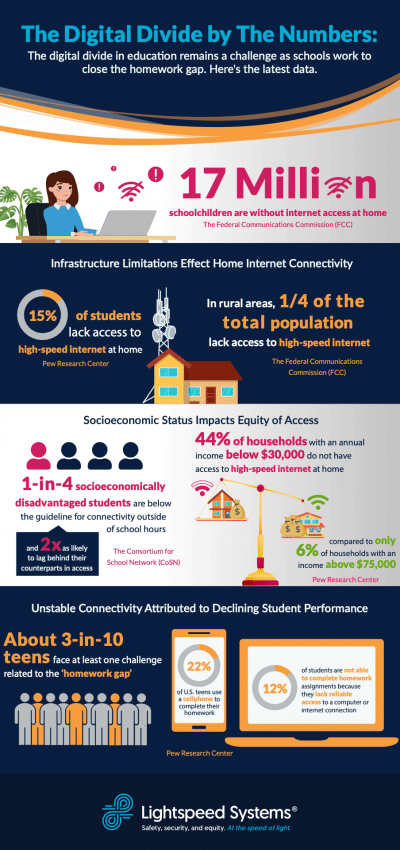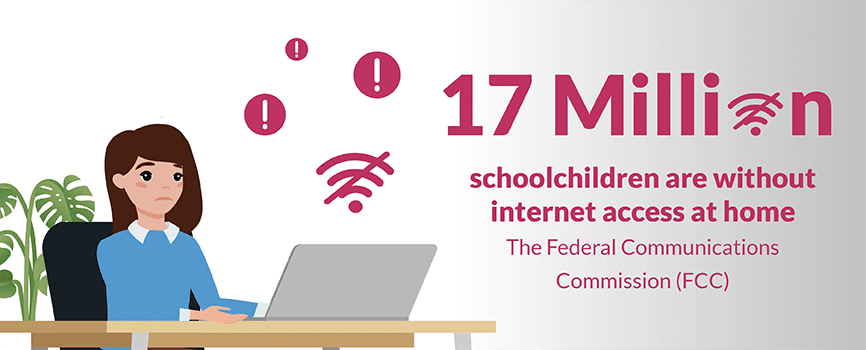What is the Digital Divide in education?
The digital divide in education refers to unequal access to technology and digital resources for learning. Disparities in digital access, also referred to in terms of digital equity, have long been a challenge for K-12 education. Thanks to long-term e-rate investments schools and libraries are connected, but post-pandemic, ensuring students have adequate internet connectivity when they leave campus is critical to academic success. The Federal Communications Commission (FCC) reports that nearly 17 million schoolchildren are without internet access at home. The “homework gap”—a disparity between students who have access to the internet and technology at home, and those who don’t—persists and is a key priority for education leaders and their communities to solve to ensure all students have equal academic opportunity.
Infrastructure limitations effect home internet connectivity and the digital divide in education
According to Pew Research Center, 15% of students still lack access to high-speed internet at home. In rural areas, the problem is even more pronounced, with one-fourth of the population—14.5 million people—lacking access to high-speed internet, according to the FCC. The report also notes that rural districts face significant challenges in providing adequate internet connectivity to bridge the digital divide in education with students due to geographic barriers and infrastructure limitations.

Socioeconomic status impacts equity of access
Research shows that the digital divide, and in turn the ‘homework gap,’ disproportionately affects low-income, rural, and communities of color. According to the 2022 CoSN Home Internet Connectivity report, one-in-four socioeconomically disadvantaged students are below the guideline for connectivity outside of school hours and are twice as likely to lag behind their counterparts in access. Pew Research Center data shows that 44% of households with an annual income below $30,000 do not have access to high-speed internet at home, compared to only 6% of households with an income above $75,000. Additionally, Black and Hispanic families are less likely to have access to high-speed internet at home than white families.
Unstable connectivity attributed to declining student performance
Lack of stable internet connectivity often affects students’ academic performance. In fact, according to the Pew Research Center, about three-in-ten teens face at least one challenge related to the ‘homework gap.’ The survey reveals 22% of U.S. teens use a cellphone to complete their homework and 12% of students are not able to complete homework assignments because they lack reliable access to a computer or internet connection. A study by Quello Center and Michigan State University found that students who do not have access to the Internet from home or are dependent on a cell phone alone for access perform lower on a range of metrics, including digital skills, homework completion, and grade point average. Further, these students are less likely to complete their homework and are more likely to drop out of school.
What can be done about the digital divide in education?
Fortunately, there are solutions to digital divide in education being developed to address the homework gap. Lightspeed Digital Insight’s new Digital Equity module provides real-time data to district leaders so that they can identify and address internet access issues for their students. The federal government has also allocated funds to help schools and districts provide high-speed internet access and devices to students who lack them. Finding a solution to the digital divide in education is a complex and persistent issue that requires continued attention and action. By working together, educators, policymakers, and technology companies can help ensure that all students have the access and resources they need to succeed academically and thrive in today’s digital world.
Want to hear how district leaders are making progress and learn about the role of technology moving forward?

